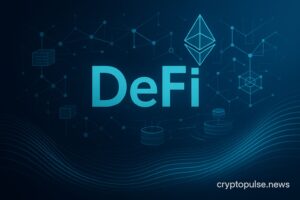What Is Ethereum and Why It Matters in Digital Finance
Ethereum is more than just a cryptocurrency — it is a decentralized platform that powers smart contracts, decentralized finance, NFTs, and a growing digital economy.
Introduction
When people think of blockchain, they often think of Bitcoin, the pioneer of digital money. But while Bitcoin’s main purpose is to serve as a store of value and medium of exchange, Ethereum expands the idea of blockchain into an entire ecosystem for applications. It has become the foundation of decentralized finance (DeFi), tokenization, NFTs, and other innovations that could reshape the future of global finance.
This article explores what Ethereum is, how it works, its history and milestones, key use cases, and its role in the evolving digital economy.
The Basics of Ethereum
Ethereum is a blockchain-based decentralized platform that allows developers to build and deploy smart contracts and decentralized applications (DApps). Unlike traditional applications, DApps run on a distributed network, making them resistant to censorship and single points of failure.
Ethereum’s native cryptocurrency is Ether (ETH), which is used to pay for network fees, power applications, and serve as collateral in decentralized finance.
Key basics include:
- Divisibility: The smallest unit of ETH is called a Wei, with 1 ETH equal to 10¹⁸ Wei. For everyday use, gas fees are measured in Gwei (1 billion Gwei = 1 ETH).
- Supply: Unlike Bitcoin’s 21 million fixed cap, Ethereum has no maximum supply. However, the introduction of EIP-1559 (fee burn mechanism) and the transition to Proof-of-Stake have reduced issuance, making ETH sometimes deflationary.
- Market capitalization: With a value of over $500 billion, Ethereum is the second-largest cryptocurrency after Bitcoin. Check our marketcap widget for actual numbers.
- ERC-20 standard: Ethereum introduced the ERC-20 token standard, which enables the creation of fungible tokens. Today, ERC-20 tokens include some of the largest stablecoins like USDT and USDC, governance tokens, and altcoins. Learn more about what are stablecoins and their role in our guide.
A Short History of Ethereum
Ethereum was first proposed in 2013 by Vitalik Buterin, who envisioned a blockchain that could go beyond simple money transfers. The idea was to build a platform where anyone could create applications on decentralized infrastructure.
Key milestones include:
- 2015 – Launch: Ethereum’s Frontier release went live, laying the foundation for smart contracts.
- 2016 – The DAO Hack & Hard Fork: A vulnerability in The DAO project led to a massive hack, forcing the community to hard fork into Ethereum (ETH) and Ethereum Classic (ETC).
- 2017 – ICO Boom: Ethereum became the launchpad for the Initial Coin Offering (ICO) wave, raising billions for blockchain startups.
- 2020 – DeFi & NFTs Rise: Protocols like Uniswap, MakerDAO, and NFT marketplaces like OpenSea surged in use, turning Ethereum into the hub of decentralized finance and digital collectibles.
- 2022 – The Merge: Ethereum transitioned from Proof-of-Work to Proof-of-Stake, cutting its energy usage by over 99% and significantly reducing new ETH issuance.
Recent milestones:
- 2024 – First ETFs and Institutional Adoption: Ethereum reached a new level of legitimacy in 2024 with the approval of the first U.S. spot Ethereum ETFs, allowing regulated exposure for retail and institutional investors. At the same time, major corporations began adopting Ethereum for tokenization of real-world assets, supply chain solutions, digital settlement systems, and treasury asset reinforcing its role as financial infrastructure.
- 2024-2025 – Scalability Progress: Alongside adoption, Ethereum advanced its scalability roadmap, with upgrades and layer-2 solutions reducing fees and improving transaction throughput, preparing the network for mass use.
In 2025, Ethereum celebrated its 10th anniversary since launch, a major milestone marking a decade of growth and innovation. For a detailed look at Ethereum’s journey, check our article: Ethereum Turns 10: Key Milestones That Shaped Web3
Key Use Cases of Ethereum
Ethereum’s adaptability and programmability have made it the backbone of the blockchain industry. Its use cases include:
- Decentralized Finance (DeFi): Platforms like Uniswap, Aave, Compound, and MakerDAO allow users to trade, lend, borrow, and earn yields without traditional banks.
- Non-Fungible Tokens (NFTs): Ethereum supports NFTs via ERC-721 and ERC-1155 standards, powering marketplaces like OpenSea and driving digital art, music, and gaming economies.
- Stablecoins: The most widely used stablecoins (USDT, USDC, DAI) run on Ethereum, handling billions in daily settlement and bridging crypto with fiat systems.
- Tokenization of Assets: Through ERC-20 and ERC-721, Ethereum enables startups and institutions to tokenize equities, real estate, and even commodities, making assets more liquid and accessible.
- DApps Beyond Finance: Ethereum powers decentralized applications for gaming, supply chain, voting systems, and identity management.
- Cross-Asset Settlement: Ethereum often acts as the settlement layer for other cryptocurrencies. Examples include wrapped Bitcoin (WBTC), stablecoins, and even BNB issued on Ethereum in its early stages.
Together, these use cases highlight Ethereum’s role not just as a currency, but as infrastructure for a decentralized economy.
Recent Developments and the Road Ahead
Ethereum is constantly evolving, with upgrades and ecosystem growth shaping its future:
- Scalability & Layer-2 Growth: Ethereum’s roadmap includes sharding and adoption of layer-2 rollups (Optimism, Arbitrum, zkSync), which drastically reduce fees and boost transaction throughput.
- Deflationary Economics: With EIP-1559 burning ETH and lower issuance post-Merge, Ethereum’s monetary policy is unique: in periods of high activity, ETH becomes deflationary, reinforcing its scarcity.
- Institutional Recognition: Spot ETFs and corporate tokenization projects establish Ethereum as a serious financial infrastructure, not just a crypto experiment.
- Developer Ecosystem: Ethereum remains the most active blockchain for developers, hosting thousands of projects and upgrades.
- Innovation in Infrastructure: New developments like Fusaka upgrade push Ethereum’s scalability and ecosystem forward, showcasing how the ecosystem is diversifying.
Ethereum’s long-term roadmap is designed to make the network more scalable, secure, and sustainable. Its adaptability ensures that Ethereum remains the leading smart contract platform well into the future.
Conclusion
Ethereum is not just a digital currency — it is the foundation of decentralized finance, tokenization, and Web3 innovation. From enabling stablecoins and NFTs to supporting enterprises and institutional investors, Ethereum has firmly established itself as a critical layer of digital finance infrastructure.
As Ethereum continues to evolve with new upgrades, broader adoption, and ongoing innovation, it remains at the forefront of the digital economy of tomorrow.








